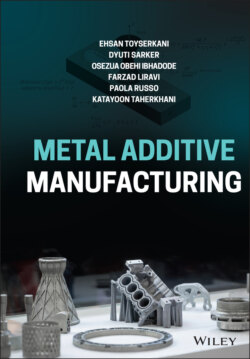Читать книгу Metal Additive Manufacturing - Ehsan Toyserkani - Страница 13
Nomenclature
ОглавлениеUnless otherwise stated in the text, these symbols have the following meanings
aCharacteristic lengthaEnergy bilinear function for internal energy (Chapter 10)ASpot area – heat source interaction areaAFilament or nozzle cross‐section area (Chapter 7)AatAttenuated areaAcCross‐section areaIntersection of melt pool area on substrate and powder streamAjetCross‐section of powder stream on substrateAGProperty of filament materialAij, BijEinstein coefficientsASSurface areabMelt pool depthbBias (Chapter 11)BSize of gap (Chapter 7)BMagnetic fieldBDifferential shape function matrix (Chapter 10)cSpeed of lightcpHeat capacitycylFunction based on Bessel functionscsSpeed of sound in the fluidCDuty cycleCCompliance (Chapter 10)CaCapillary numberCsSolid compositionCLLiquid compositionCNominal alloy composition or solute concentrationdSpot sizedEuclidean distance (Chapter 11)dDroplet diameterd3, 2Surface mean particle diameterdconSemispherical dropletDLaser beam diameterDMaterial matrixDfDiffusion constantDijmnTensor of elastic coefficientsDLSolute diffusion coefficientDØDiffusion coefficienteWhen subscript or superscript, signifies a variable in its elemental formeiVector pointingELaser beam energyEElectric field (Chapter 5)EYoung’s modulus matrix (Chapter 10)EaEnergy of activationEbE‐beam energyEiInput laser energyEkinKinetic energyErReflected energyEtTransmitted energyEiEnergy levels (Chapter 3)EspecificThe energy enters the substrate from the surface in DEDfFrequencyfVolume fraction (Chapter 10)fsFraction of solidfLFraction of liquidf(R)Function of surface roughnessfi(x, t)Density of particles moving in the ei directionEquilibrium distributionFForceFFourier numberZero‐order Bessel function of its first kindThe first‐order Bessel function of the first kindFCapCapillary forceFstSurface tension forceFthThermal stress loadFWetWetting forcegGravitygiEffect of external forcesGTemperature gradientGSGibbs free energy for solidGLGibbs free energy for liquidGzGraetz numberΔGTotal Gibbs free energy changeΔG*Critical free energy changeΔGVFree energy change per unit volumehPlank's constant (Chapter 3)hHeight of a hexahedral element (Chapter 10)hcHeat convection coefficienthiConvective heat loss (cooling) coefficientshaAverage heat transfer coefficient of convectionhwDistance between the nozzle and surfacehrRadiative heat transfer coefficient hminMinimum radius of the liquid columnHBarrel length or height of trackH*Height of the melt polymer∆HEnthalpy differenceHDRHeating depth ratioIIntensity: energy per areaICurrent in electron beam (Chapter 5)I(x)Indicator function (Chapter 11)IIntensity scale factor or initial intensityIbBeam current in the electron‐beam processJFree electron currentkPropagation factorkEquilibrium distribution coefficient (Chapter 8)kSolute partition coefficient (Chapter 9)KThermal conductivityKGlobal stiffness matrix (Chapter 10)KcConductivity matrix (Chapter 10)KhConnective matrix (Chapter 10)K*Modified thermal conductivityKBessel function of the second kind and zero orderlLayer thicknesslLoad linear function for external work (Chapter 10)LTransformation matrixLLink intensityLcCharacteristic length based on domain sizeLfLatent heat of fusionLaguerre polynomial of order p and index lmAtomic massmbMass of the ball (Chapter 9)mbDeposited binder (Chapter 6)mpParticle massmpMass of the bound powder (Chapter 6)mfFluid massMass flow rateM2Beam quality factorMaMarangoni numbernReflection's indexNMatrix of shape function for mesh elementNiNumber of atoms or electrons per unit volume in the energy levelsNLAmount of atoms per unit volume of liquidNlxNeumann functionNSAmount of atoms per unit volume of solidNuNusselt numberNthShape vector for thermal expansionOhOhnesorge number pConstant characteristic of the material (Chapter 4)pPressurepPenalty value (Chapter 10)pcCapillary forcePfPacking fractionPPowerPatAttenuated laser power by particlesPelPower of electrical motor in FDM systemPlNet/average laser powerPpeakPeak power per pulsePonOn the state of the laser powerPoffOff state of the laser powerPtotTotal delivered beam powerPePeclet numberPrPrandtl numberPRPacking density of the powderPWPulsed wave laserP(∞)Value of the extrudate property after an infinite healing timeqHeat fluxQPower generated per unit volume (in all chapters except Chapter 3)QBeam propagation factor (Chapter 3)QcTotal energy absorbed by the substrateQextExtinct coefficientQlLaser energyQrsReflected energy from the substrateQLLatent energy of fusionQvVolumetric flow raterRadius of nucleus (Chapter 8)r*Critical nucleus radiusrbBall mill radiusrfFilament radiusr0lBeam radius of the waistrjetRadius of powder spray jetrlBeam spot radius on the substratersPowder stream diameterrpPowder particle radiusRReflectivityRSolidification rate where it is referred toRcClad surface curvatureRcurRadius of curvatureReReynolds numberRe*Property‐based Reynolds numberRhHeat load by convectionRh(t)Intrinsic healing functionRLLocal growth rate RNNominal growth rateRrRadius of the actuating motorRporeEffective pore diameter in the bedRqHeat load by surface conductionRQHeat load by volume conductionsHatch spacingsSpecific surface areaSBinder saturationSijLateral distance between neuron i and j (Chapter 11)SmaxSpreading ratioSmeasAmount of signal (Chapter 11)SØSource term corresponding to ØS (ϕ)Shape factorSSScan speedStrain rate deformation tensorΔ SExpansion of surface areatTime and/or laser interaction timet*Dimensionless timetc = tμViscous timetCDACorresponding penetration timetfSolidification timetIInertial‐capillary timetVViscous‐capillary timeTTemperatureTαReference temperatureTaveAverage temperatureTinFilament temperatureTgGlass transition temperatureToutOutlet temperatureTemperature of the liquefier wallTdDrying timeTeEquilibrium temperatureTlLiquidus temperatureTAmbient temperatureTmMaterials melting pointTpMaximum temperatureΔTUndercooling temperatureΔTtotTotal undercooling temperatureΔTCUndercooling temperature: solute diffusionΔTTUndercooling temperature: thermal diffusionΔTKUndercooling temperature: attachment kineticsΔTRUndercooling temperature: solid–liquid boundary curvatureTEMplGaussian–Laguerre transverse electromagnetic modesUBeam velocityUTravel velocity vectorUGlobal displacement vector (Chapter 10)UpParticle velocity vectorUsRate of solidificationvScanning speedvcCollision velocityυjJet velocityvpVelocity of the particlevprintVelocity of the print headVVolume of melt poolVDesign volume (Chapter 10)VaAcceleration voltageVSVolume of nucleusVEDThe energy enters the substrate from the surface in LPBFwTrack or melt pool widthwNeuron weight (Chapter 11)wiWeight factorWLaser pulse widthWeWeber numberXs + cWeight percent of element X in the total surface of the clad regionXcWeight percent of element X in the powder alloyXsWeight percent of element X in the substrateyDendrite arm spacing (Chapter 8)zDistance from the surfacezWaist location with respect to an arbitrary coordinate along the propagation axisZPrintability of a liquidZhHeat penetration depth
